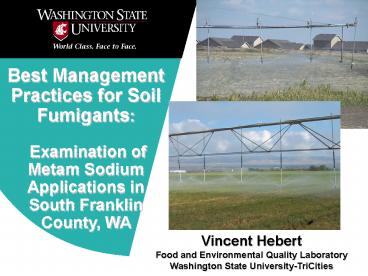Best Management Practices for Soil Fumigants: - PowerPoint PPT Presentation
1 / 26
Title: Best Management Practices for Soil Fumigants:
1
Best Management Practices for Soil Fumigants
Examination of Metam Sodium Applications in South
Franklin County, WA
Vincent Hebert Food and Environmental Quality
Laboratory Washington State University-TriCities
2
(No Transcript)
3
(No Transcript)
4
Large scale PNW potato production operations rely
on center pivot applications
5
Major PNW Soil Fumigant
- Metam Sodium Sodium methyl dithiocarbamate
(biologically active ingredient, methyl
isothiocyanate) - Efficacious and cost effective fumigant for
control of verticillium wilt, nematodes
6
Top Ten Crop Uses for Metam Sodium 2004
Source EPA 6/2005
x 1,000,000 Pounds
7
Usage of Metam Sodium as a Pre-Plant Fumigant
2005 Data
Source USDA NASS 2006
8
Metam Sodium Converts Rapidly to MITC
Water Solubility 578 g/L Vapor Pressure 4.3 x
10-4 mm Hg
Metam sodium
Water Solubility 8.94 g/L Vapor Pressure 20
mm Hg
Methyl isothiocyanate (MITC)
9
(No Transcript)
10
(No Transcript)
11
(No Transcript)
12
Franklin County MITC Air Monitoring Program
September 26 October 25, 2005
13
2006 WSU-FEQL Western Farm Service
Metam Product Stewardship
- Best management chemigation tactics
- Best management soil incorporated shank injection
14
WSU-Western Farm Service Product
Stewardship Study
Study Design
Chemigation Sectagon 42 was commercially applied
_at_ 40 gallons/acre using ca. 1 inch of water to
set the product at a desired soil depth. Time to
complete the application over the 33 acre circle
was ca. 2 days Soil-incorporated Shank
Injection Sectagon 42 was applied by shank
injection with soil compaction to the 119 acre
field according to label requirements. The time
to complete this application was ca. 2 work days
Air Monitoring Uniform siting procedures at the
two field plots included positioning a minimum of
eight mast air samplers around the periphery of
the field. Air were monitored pre-application,
mid-application, and at discrete interval to 4
days post-application Chemical Analysis
Analysis of MITC from charcoal cartridge
adsorbent cartridges by gas chromatography with
thermal ionic specific detection
15
MITC Air Sampler Siting Locations
33 or 119 acre center pivot
Prevailing wind direction
25
200
500
approx. meters
Air sampler
Weather station
16
(No Transcript)
17
Whole Field MITC Emissions for BMP Chemigation
and Shank Injected Circles
18
Post Application Off Target Air Emission for
Chemigation and Soil Incorporated Shank Injection
19
Maximum Downwind MITC Concentrations
20
Minimizing Fumigant Inhalation Exposures
Implications for PNW Agriculture
EPA Proposed Mitigation Measures That Would
Directly Reduce Potential Acute Inhalation and
Other Risks 1. Buffer Zones 2. Sealing
Methods 3. Timing of Applications 4. Application
Block Limits 5. Respiratory protection 6. Tarp
Cutting and Removal 7. Entry-Restricted Period 8.
Application Method/Practice Restrictions
21
Minimizing Fumigant Inhalation Exposures
Implications for PNW Agriculture
EPA Proposed Mitigation Measures That Would
Directly Reduce Potential Acute Inhalation and
Other Risks 1. Buffer Zones 2. Sealing
Methods 3. Timing of Applications 4. Application
Block Limits 5. Respiratory protection 6. Tarp
Cutting and Removal 7. Entry-Restricted Period 8.
Application Method/Practice Restrictions
22
Distributional/Probabilistic Model Buffer Zone
Scenarios
23
California DPR Buffer Specifications
Mitigation Proposal FINAL DRAFT Control of
Off-Site and Bystander Short-Term Exposure to
Methyl Isothiocyanate (MITC) From Metam Sodium
and Metam Potassium Applications. January 5, 2007
Department of Pesticide Regulation California
Environmental Protection Agency
24
Implications for PNW ?
2007- 2009 Areas of Investigation
- Residential air monitoring
- Reduced rate efficacy and BMP shank trials
- Field flux determinations
- Dispersion modeling
25
18-24 inches
Drop Extension Cost ? 0.80 per Nozzle
26
Thanks go to
Western Farm Service University of Washington
(PNASH) Washington Department of Health
Washington Department of Agriculture South
Franklin county growers and residences who
participated in 2005 monitoring and 2006 best
management practice studies






























